2017 Lubec photo workshops: dates just announced
(See below)
Monument to Lost Fishermen
Documenting a Maine town's tribute to its fallen
By Frank Van Riper
Photography Columnist
Those who go down to the sea in ships,
Who do business on great waters;
They have seen the works of the Lord,
And His wonders in the deep. (Psalm 107)
The elegant cadences of the King James Bible describe what it is to be a fisherman and to confront the uncertainty of a roiling unforgiving sea.
It is a hard life, but in places like Down East Maine—where my wife Judy and I have lived every summer for the past 30 years—it is a life that few would forsake.
To be a fishermen (male or female) is to be at one with nature, to be one’s own boss, and to enjoy the satisfaction of making a living in proportion to one’s labors.
But not without cost.
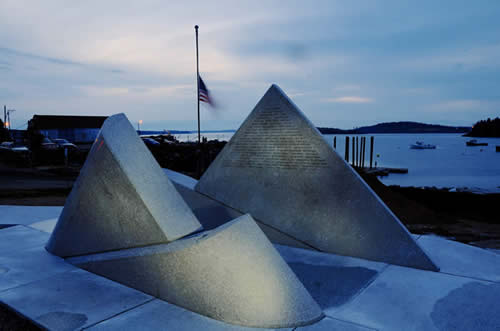 |
The Lost Fishermen's Memorial, by Jesse Salisbury of Steuben, Maine, now anchors the end of Water Street by the town dock in Lubec. The elegant granite sculpture is an moving tribute to the fallen that lends itself to myriad photographic interpretation.
© Frank Van Riper |
On a perfect summer’s day last August the communities of Lubec, Maine and Campobello, New Brunswick came together to dedicate a beautiful granite memorial to their lost fishermen amid ceremony, song, remembrance and tears.
More than seven years from concept to completion, the eloquent memorial, designed by sculptor Jesse Salisbury, now anchors Lubec's Water Street in a memorial park at the town dock. At the ceremony speakers from the Maine state legislature, Lubec, Campobello, and the Passamaquoddy Nation joined a huge crowd of townspeople and visitors to remember those who set out to sea and never came back.
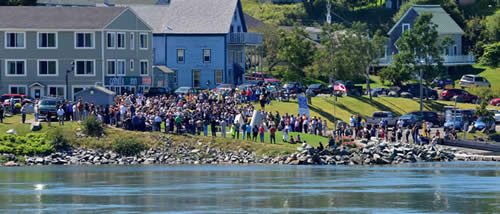 |
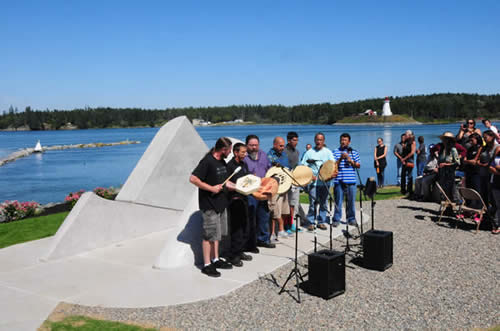 |
| The skies were perfect for the dedication ceremony last August that attracted a huge crowd (above.) Included in the program were members of the Passamaquoddy Nation near Eastport who sang and drummed in a purification rite for the granite sculpture. Top © Bernard Williams; Bottom © Frank Van Riper |
This stark memorial, evoking two complementary wave forms, means so much to the people in our adoptive summer town because everyone there--everyone--knows, or knows of, someone who has died at sea. The names of the Washington County, Maine and Campobello, NB, dead are engraved on the stone, and after the sculpture was installed, some approached hesitantly and in tears to see and touch the names of their loved ones. I am proud that Judy and I—as well as our workshop students this past summer--were able to create a visual record of the monument for them.
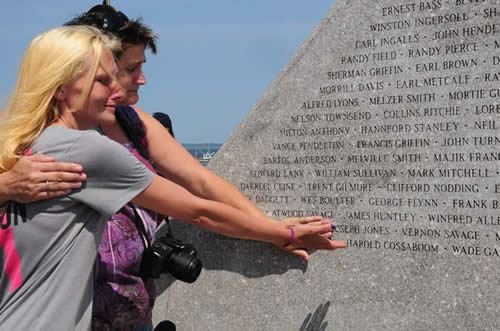 |
| A weeping Jessica Jones, foreground, touches the name of her late brother Joseph, as Shelley Corey Tinker, who helped lead the Memorial effort and who herself is married to a fisherman, embraces her. © Frank Van Riper |
Surprisingly, for such a comparatively small and isolated town—it literally is at the easternmost point in the United States—Lubec, Maine now boasts not one but two world-class public sculptures in dramatic settings. The first was “Beyond the Horizon,” a stunning monolith depicting earth, sea and sky that was crafted by Valerian Jikia from the Republic of Georgia. The work was part of the Schoodic International Sculpture Symposium’s effort to grace towns along the down east coast with monumental sculpture made of native Maine granite. It sits alone and imposing in Lubec’s Stockford Park, within sight of the international bridge linking Lubec to Campobello.
Located at the other end of Water Street, The Lost Fishermen’s Memorial was not part of the Sculpture Symposium but has strong ties to it since Salisbury, 44, from Steuben, Maine, founded the Sculpture Symposium several years ago to promote public art. As with “Beyond the Horizon,” no public money was used to finance the Lost Fishermen’s Memorial.
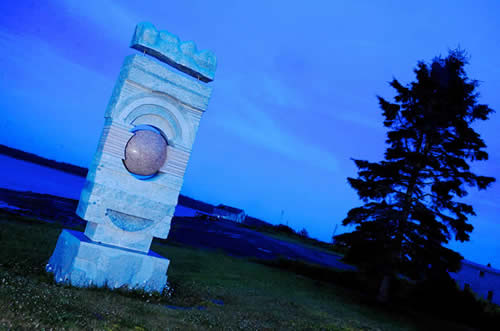 |
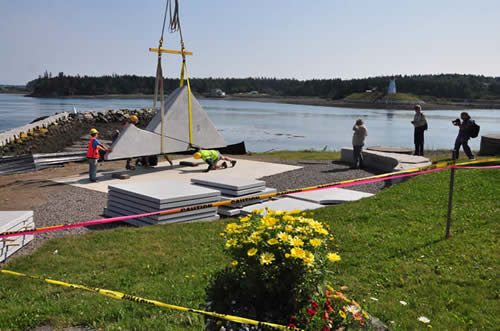 |
| Top: 'Beyond the Horizon' by Valerian Jikia. Bottom: the first part of the Lost Fishermen's Memorial is carefully set in place. Top: © Frank Van Riper; Bottom: © Judith Goodman |
Besides the sculpture’s stark beauty and emotional tie to the Lubec community, what drew me to it—and before that to “Beyond the Horizon”--were the myriad possibilities to photograph it.
In some ways this is portraiture—though with a subject that never moves or changes expression. In this case I would create different moods or “expressions,” by shooting under different lighting conditions and/or by manipulating the light I brought to the site.
And, in fact, for the past two summers, I have made photographing these sculptures an integral part of Judy’s and my photographic workshops in Lubec, as well as of my more intense photo Master Classes. (For information: www.Summerkeys.com, or GVR@GVRphoto.com)
This past summer also provided us the chance to photograph the actual installation of the multi-ton Memorial, each component gingerly lifted by a humongous crane onto a specially prepared concrete slab, under the careful eye of Jesse Salisbury. The images that we and our students made were amazing, largely because of the up-close access that we were granted by project manager Bill Case. Bill, whom we’ve gotten to know over the years, figured we had sense enough to stay out of harm’s way, and that we’d do the same for our students.
Worked like a charm. (Thanks again, Billy.)
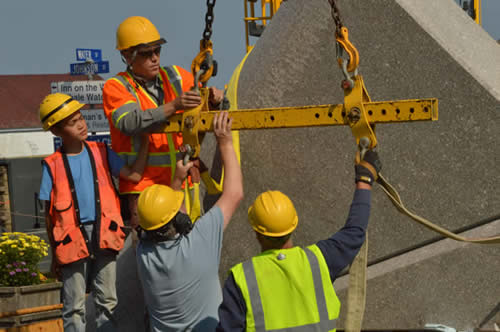 |
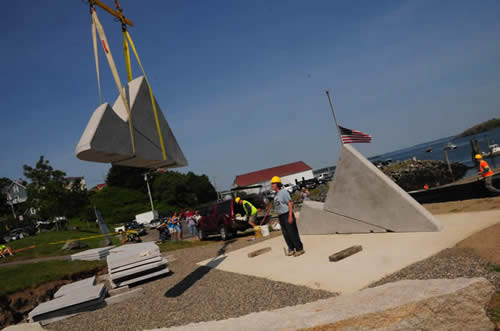 |
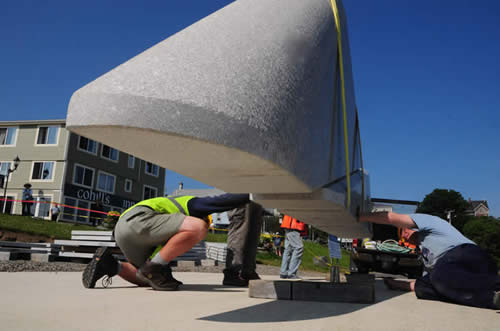 |
| Top: Sculptor Jesse Salisbury (sunglasses) guides installation of his work as his young son looks on. Center: Second section of memorial is guided into place. Bottom: Piece looms as crew prepares to set it on its pins. Top: © Jackie Flaherty; Center and Bottom: © Frank Van Riper |
Sitting at the easternmost point in the country—with wide-angle water views everywhere—Lubec routinely offers spectacular sunsets that can produce dramatic photos, requiring little more effort than pointing one’s iPhone at the sky.
The drawback, though, is that every minute that passes, increasing the drama of the evening sky, also darkens everything on land and in the foreground. If all you care about is the sky, no problem—your foreground will appear largely in silhouette and, when you post your image on Facebook, everyone will think you’re a genius.
When photographing the Lost Fishermen’s Memorial, however, we were faced with the dilemma of wanting the most dramatic night sky we could get while also wanting enough light to render the sculpture well.
Which is why, on several evenings over the summer—during several workshop classes—a small group of us could be seen lugging tripods, lightstands, portable strobe units and high-intensity flashlights to the memorial site as the evening light waned and the sky became dramatic. We used several techniques, many simultaneously: painting with continuous light during a long exposure, aiming small slave-powered flash units at the engraved names on the Memorial; popping portable strobe units multiple times at different spots on the sculpture; extending our exposure times for light painting by using various grades of neutral density filter.
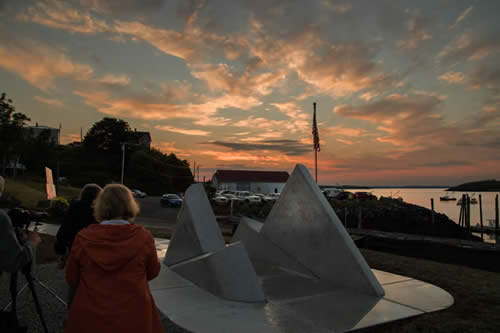 |
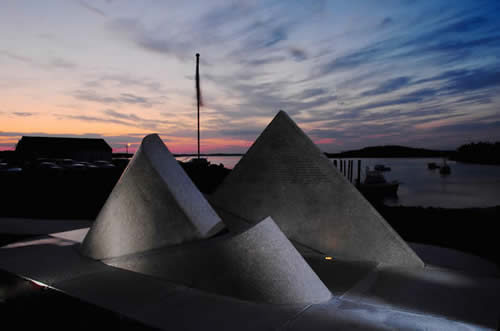 |
| Top: Our students can be seen in foreground with lightstands and tripods as we prepare for an evening shoot. Bottom: final image combines dramatic sky with multiple strobe pops and continuous high-intensity light on the sculpture. Top: © Stu Schaffner; Bottom: © Frank Van Riper |
No one technique worked best; it all depended on what you were after and how the available light melded with what you brought to the shoot.
And no one had a monopoly on the best shooting position. In fact, one of the best images from last summer was one that I saw on Facebook: a wide shot of the Memorial park at dawn.
I wish I had made it. I probably will next year.
-----
Lubec Photo Workshops at SummerKeys, Lubec, Maine -- Summer, 2017 dates just announced...
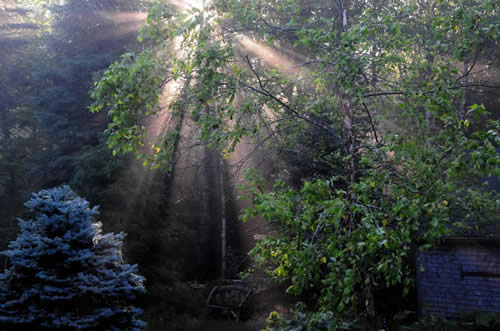
Daunted by Rockport??
Spend a week of hands-on learning and location photography with award-winning husband and wife photographer-authors Frank Van Riper and Judith Goodman. Frank and Judy will cover portraiture, landscape and documentary photography during morning instruction, followed by assignments in multiple locations including Quoddy Head State Park, Campobello Island, NB and the colorful town of Lubec itself. Daily critiques and one-on-one instruction. NO entrance requirement. Minimum age for attendance is 16. Maximum number of students each week is nine. Students supply their own digital camera.
The Lubec Photo Workshops debuted in 2009 and were a huge success for their low-key, no-pressure atmosphere. Note: Classes fill early.
2017 workshop dates: July 17-21; July 31-August 4; August 14-18.
Tuition payable through the SummerKeys Music Workshops: www.SummerKeys.com
Or contact us: GVR@GVRphoto.com
NEW: Master Photo Classes with Frank Van Riper
These intense, three-day, limited enrollment classes are aimed at the more advanced student, who already has taken a photo workshop and who is familiar with basic flash. With a maximum enrollment of just five, these classes are nearly half the size of our regular workshops. NB: last summer's Master Classes were fully booked almost immediately.
2017 Master Photo Class dates:July 24-26; August 21-23
Come photograph in one of the most beautiful spots on earth!
-----------
Van Riper Named to Communications Hall of Fame
 |
| Frank Van Riper addresses CCNY Communications Alumni at National Arts Club in Manhattan after induction into Communications Alumni Hall of Fame, May 2011. (c) Judith Goodman |
[Copyright Frank Van Riper. All Rights Reserved. Published 9/16]
|